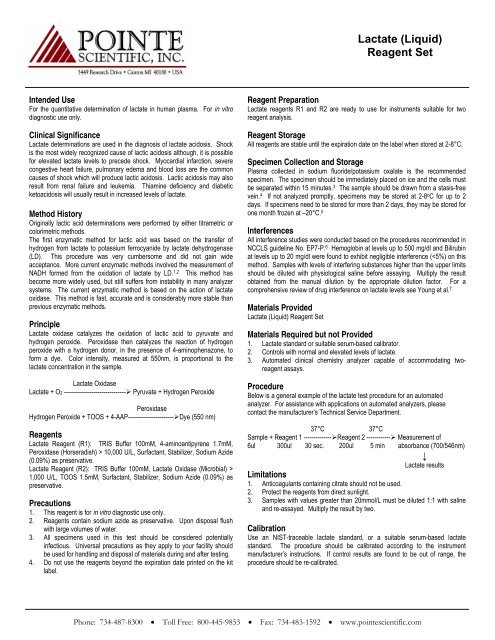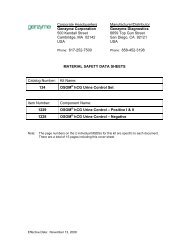Package Insert - BioPacific Diagnostic Inc.
Package Insert - BioPacific Diagnostic Inc.
Package Insert - BioPacific Diagnostic Inc.
Create successful ePaper yourself
Turn your PDF publications into a flip-book with our unique Google optimized e-Paper software.
Lactate (Liquid)<br />
Reagent Set<br />
Intended Use<br />
For the quantitative determination of lactate in human plasma. For in vitro<br />
diagnostic use only.<br />
Clinical Significance<br />
Lactate determinations are used in the diagnosis of lactate acidosis. Shock<br />
is the most widely recognized cause of lactic acidosis although, it is possible<br />
for elevated lactate levels to precede shock. Myocardial infarction, severe<br />
congestive heart failure, pulmonary edema and blood loss are the common<br />
causes of shock which will produce lactic acidosis. Lactic acidosis may also<br />
result from renal failure and leukemia. Thiamine deficiency and diabetic<br />
ketoacidosis will usually result in increased levels of lactate.<br />
Method History<br />
Originally lactic acid determinations were performed by either titrametric or<br />
colorimetric methods.<br />
The first enzymatic method for lactic acid was based on the transfer of<br />
hydrogen from lactate to potassium ferrocyanide by lactate dehydrogenase<br />
(LD). This procedure was very cumbersome and did not gain wide<br />
acceptance. More current enzymatic methods involved the measurement of<br />
NADH formed from the oxidation of lactate by LD. 1,2 This method has<br />
become more widely used, but still suffers from instability in many analyzer<br />
systems. The current enzymatic method is based on the action of lactate<br />
oxidase. This method is fast, accurate and is considerably more stable than<br />
previous enzymatic methods.<br />
Principle<br />
Lactate oxidase catalyzes the oxidation of lactic acid to pyruvate and<br />
hydrogen peroxide. Peroxidase then catalyzes the reaction of hydrogen<br />
peroxide with a hydrogen donor, in the presence of 4-aminophenazone, to<br />
form a dye. Color intensity, measured at 550nm, is proportional to the<br />
lactate concentration in the sample.<br />
Lactate Oxidase<br />
Lactate + O2 -------------------------------‣ Pyruvate + Hydrogen Peroxide<br />
Peroxidase<br />
Hydrogen Peroxide + TOOS + 4-AAP-----------------------‣Dye (550 nm)<br />
Reagents<br />
Lactate Reagent (R1): TRIS Buffer 100mM, 4-aminoantipyrene 1.7mM,<br />
Peroxidase (Horseradish) > 10,000 U/L, Surfactant, Stabilizer, Sodium Azide<br />
(0.09%) as preservative.<br />
Lactate Reagent (R2): TRIS Buffer 100mM, Lactate Oxidase (Microbial) ><br />
1,000 U/L, TOOS 1.5mM, Surfactant, Stabilizer, Sodium Azide (0.09%) as<br />
preservative.<br />
Precautions<br />
1. This reagent is for in vitro diagnostic use only.<br />
2. Reagents contain sodium azide as preservative. Upon disposal flush<br />
with large volumes of water.<br />
3. All specimens used in this test should be considered potentially<br />
infectious. Universal precautions as they apply to your facility should<br />
be used for handling and disposal of materials during and after testing.<br />
4. Do not use the reagents beyond the expiration date printed on the kit<br />
label.<br />
Reagent Preparation<br />
Lactate reagents R1 and R2 are ready to use for instruments suitable for two<br />
reagent analysis.<br />
Reagent Storage<br />
All reagents are stable until the expiration date on the label when stored at 2-8°C.<br />
Specimen Collection and Storage<br />
Plasma collected in sodium fluoride/potassium oxalate is the recommended<br />
specimen. The specimen should be immediately placed on ice and the cells must<br />
be separated within 15 minutes. 3 The sample should be drawn from a stasis-free<br />
vein. 4 If not analyzed promptly, specimens may be stored at 2-8 o C for up to 2<br />
days. If specimens need to be stored for more than 2 days, they may be stored for<br />
one month frozen at –20°C. 5<br />
Interferences<br />
All interference studies were conducted based on the procedures recommended in<br />
NCCLS guideline No. EP7-P. 6 Hemoglobin at levels up to 500 mg/dl and Bilirubin<br />
at levels up to 20 mg/dl were found to exhibit negligible interference (
Lactate (Liquid)<br />
Reagent Set<br />
Quality Control<br />
Reliability of test results should be routinely monitored with control materials<br />
that reasonably emulate performance of patient specimens. Quality control<br />
materials are intended for use only as monitors of accuracy and precision.<br />
The recovery of control values within the appropriate range should be the<br />
criteria used in evaluation of future assay performance. Controls should be<br />
run with every working shift in which lactate assays are performed. It is<br />
recommended that each laboratory establish their own frequency of control<br />
determination. Quality control requirements should be determined in<br />
conformance with local, state, and/or Federal regulations or accreditation<br />
requirements.<br />
Results<br />
To convert from S.I. units to conventional units, multiply the S.I. units by<br />
9.01.<br />
Example: mmol/L x 9.01 = mg/dL Lactate<br />
Expected Values<br />
The following reference range is suggested for L-Lactate. 8<br />
Venous<br />
Arterial<br />
0.5-2.2 mmol/L<br />
0.5-1.6 mmol/L<br />
It is highly recommended that each laboratory establish its own range of<br />
expected values.<br />
Performance<br />
1. Assay Range: 0-20 mmol/L<br />
2. Comparison: This lactate reagent was compared to the method<br />
performed on the Dade Chemistry Analyzer. The study was performed<br />
using 57 patient samples ranging from 0.3-10.4 mmol/L. Data was<br />
subjected to least-squares linear regression analysis which yielded a<br />
correlation coefficient(r) of 0.998 with a regression equation of y = 0.97<br />
x + 0.1.<br />
3. Precision: Within-Day precision for the Lactate Reagent was<br />
determined following a modification of NCCLS document EP5-T2. 9<br />
Within-Day precision studies produced the following results:<br />
Within Day<br />
Sample N Mean S.D. C.V.%<br />
Low 20 1.52 0.04 2.63<br />
Mid 20 3.98 0.07 1.76<br />
High 20 8.89 0.09 1.01<br />
References<br />
1. Gutmann, I., Wahlefeld, A., Methods of Enzymatic Analysis. 2 nd Ed.,<br />
Academic Press, New York, 1974, 1464.<br />
2. Noll, F., Methods of Enzymatic Analysis. 2 nd Ed., Academic Press, New<br />
York, 1974, 1465.<br />
3. Tietz, N.W., Fundamentals of Clinical Chemistry, 4 th Ed., W.B. Saunders<br />
Company, Philadelphia, 1996, 367.<br />
4. Tietz, N.W., Clinical Guide to Laboratory Tests, 3 rd Ed., W.B. Saunders<br />
Company, Philadelphia, 1995, 382-383.<br />
5. Westgard, J.O., Lahmeyer, B.L, Birnbaum, M.L, Clin Chem 1972, 18:1334-<br />
1338.<br />
6. National Committee for Clinical Laboratory Standards, National Evaluation<br />
Protocols for Interference Testing, Evaluation Protocol Number 7, Vol. 4, No.<br />
8, June 1984.<br />
7. Young, D.S., effects of Drugs on Clinical Laboratory Tests, 3 rd Ed., AACC<br />
Press, Washington D.C., 1990.<br />
8. Tietz, N.W., Fundamentals of Clinical Chemistry, 4 th Ed., W.B. Saunders<br />
Company, 1996, 801.<br />
9. NCCLS document “Evaluation of Precision Performance of Clinical<br />
Chemistry Devices” 2nd Ed., 1992.<br />
Manufactured by Pointe Scientific, <strong>Inc</strong>.<br />
5449 Research Drive, Canton, MI 48188<br />
European Authorized Representative:<br />
Obelis s.a.<br />
Boulevard Général Wahis 53<br />
1030 Brussels, BELGIUM<br />
Tel: (32)2.732.59.54 Fax:(32)2.732.60.03 email: mail@obelis.net<br />
Rev. 12/09 P803-L7596-01<br />
Day To Day precision was also determined following a modification of<br />
NCCLS document EP5-T2. 9 Day to Day precision studies produced<br />
the following results:<br />
Day To Day<br />
Sample N Mean S.D. C.V.%<br />
Low 20 1.51 0.04 2.65<br />
Mid 20 4.12 0.09 2.18<br />
High 20 9.19 0.17 1.85<br />
4. Sensitivity: The analytical sensitivity for lactate was determined to be<br />
0.15 absorbance units per 1 mmol/L of lactate.
















